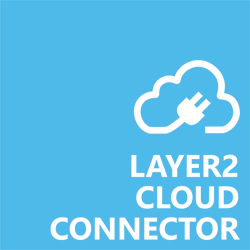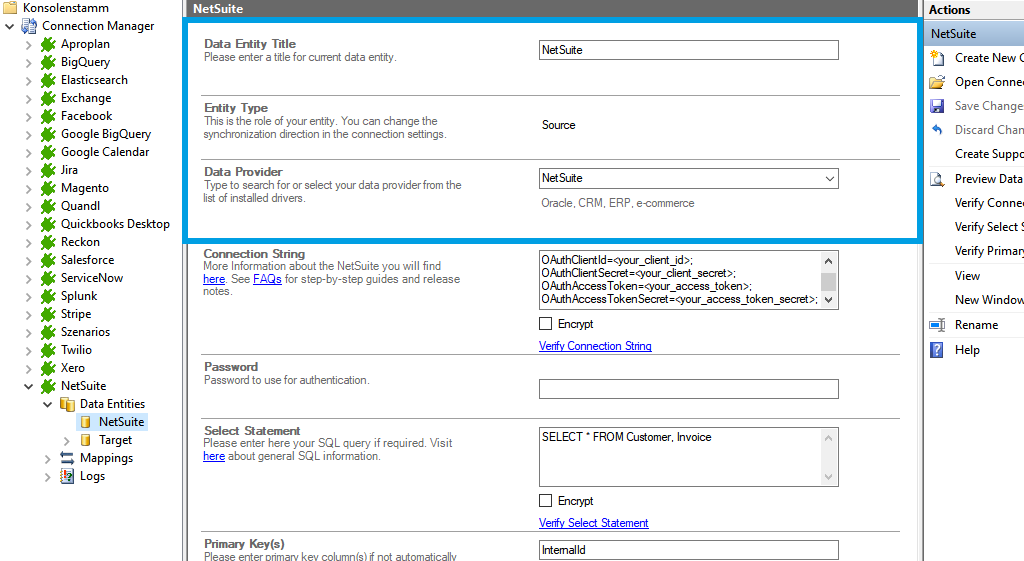Keep
your NetSuite in sync. Download and try the Layer2 Cloud Connector today.
NetSuite Integration with Office 365, SharePoint and 150+
NetSuite data can be integrated and synchronized codeless with various other data sources, on-premises or in the cloud, using the Layer2 Cloud Connector Enterprise Edition via our NetSuite Data Provider. Please take a look here for supported systems and applications.
To connect to NetSuite data the data source entity must be configured as follows in the Layer2 Cloud Connector Connection Manager:
Fig. Example connection configuration to connect to NetSuite data.
NetSuite Integration and Synchronization Specific Settings
Please note the following specific settings.
- Choose "NetSuite" as the Data Provider for your data entity (source and / or destination).
- Example connection string with minimum required items:accountid=myAccountID; user=myUserID; password=myPassword
- There are other parameters, like RoleID, that are optional.
- No installation or modification is required on the NetSuite side.
- SQL-like select statements are supported to query NetSuite data entities with this provider.
- You can map the resulting data fields to specific external fields in the Layer2 Cloud Connector. Please take care about data types (simple type conversions are supported).
- Please enter an appropriate primary key (column with unique values), depending on query (see data preview for this). It is often the InternalID or the ExternalID.
- You can use the connection for uni- or bi-directional synchronization. In case of inserts (full CRUD) via external systems please take care of the primary key and any additional mappings requireed to make it work (see Known Issues section below for more information)
- Data synchronization can be started manually in the Connection Manager, per command line or scheduled in background by the Layer2 Cloud Connector Windows Service. Only data changes are processed (no delete / bulk import).
- No programming required for setup a connection and sync.
- No need to open your local network for access from outside.
NetSuite Integration - Known Issues and Workarounds
- While NetSuite does have an SOAP service option, it is not currently compatible with the Layer2 Beta SOAP provider.
- With writing back to NetSuite with bi-directional, you must be careful about which fields are mapped. In some cases, the field is actually fed from a list or record, and if you don't include a mapped reference to that list/record (typically styled as "fieldName_InternalID"), then the update will fail. Also be aware per the Provider documentation, that the InternalID (primary key) is required for Insert/Update/Delete actions.
Step-by-Step Intros For NetSuite Data Integration and Synchronization
Just some interesting scenarios to sync NetSuite data with almost any other system or application:
- Sync with local SQL or SQL Azure for better reporting.
- Sync with Microsoft Exchange (on-premises or online) for notifications, tasks, calendar events, mobile access and offline availability on any device.
- Sync with 3rd party tools based on SQL databases like Oracle, mySQL or Microsoft SQL Server.
- Sync with Microsoft SharePoint or Office 365 for better collaboration (for example with customers or partners) or for intranet publishing.
OAuthClientID=<your_client_id>;
OAuthClientSecret=<your_client_secret>;
InitiateOAuth=GETANDREFRESH;
Select Statement:
SELECT * FROM Messages WHERE ChannelID=’CBZVAAE6L’ AND SearchTerm Like ‘’;
You can get all available tables with:
SELECT * FROM sys_tables;
You can get all available views with:
SELECT * FROM sys_views;
Ready to go next steps?





